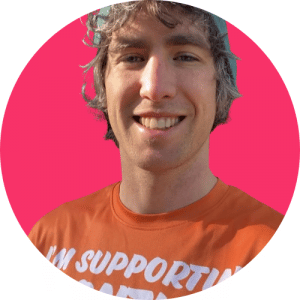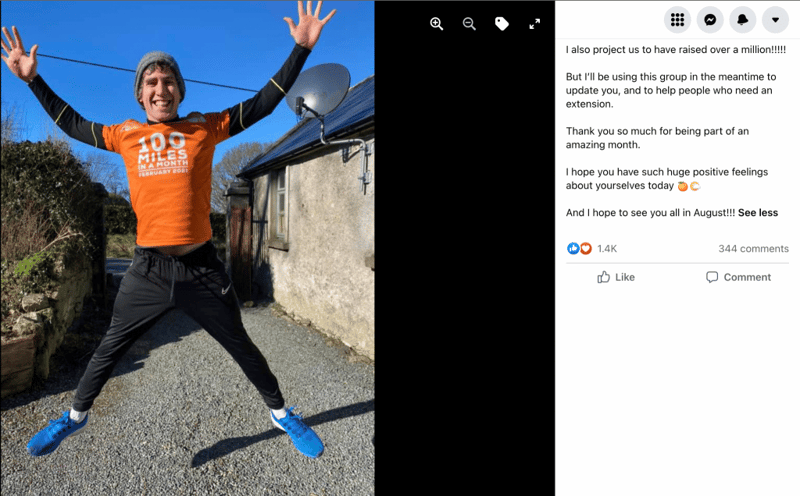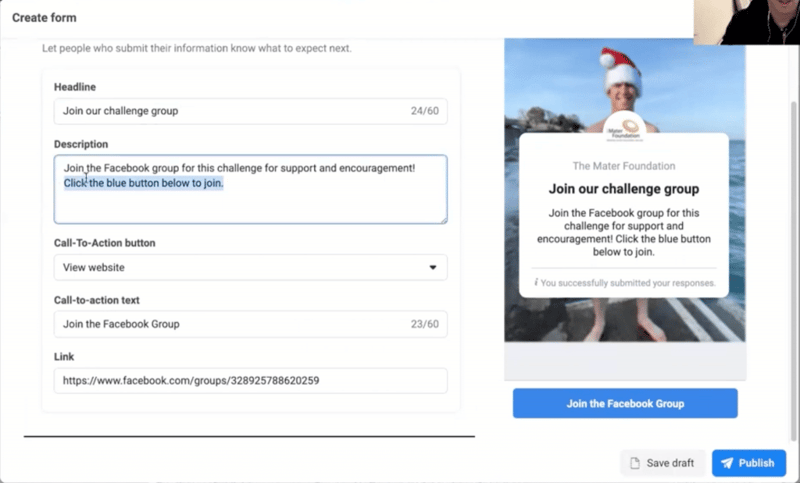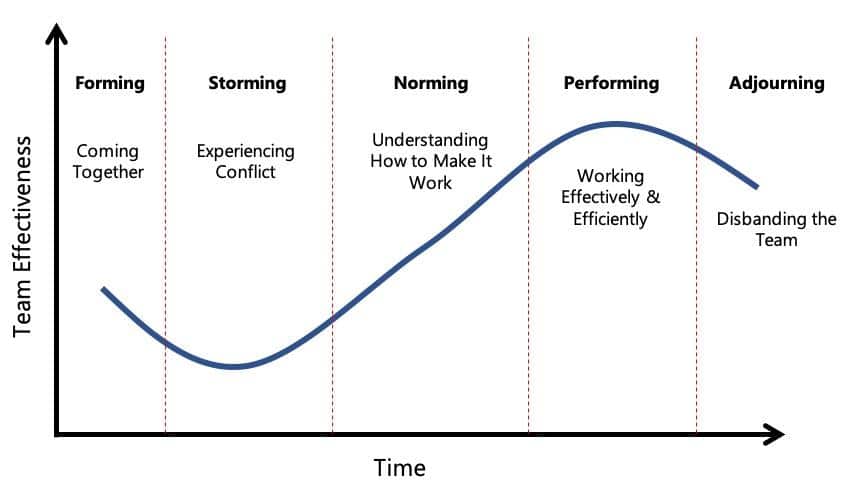Blog 4 steps to engage your Facebook Group and get them fundraising

4 steps to engage your Facebook Group and get them fundraising
Facebook Groups are at the heart of the Facebook Challenge fundraising model. But what is a Facebook Challenge?
Simply put, as an organization you choose a trackable goal for your supporters to complete within a time limit – eg. ‘1000 squats in May for tiger conservation’. They will then share their ambitions with their friends in order to raise funds for you.
Prospective supporters will initially sign up to adverts for your Challenge, but their conversion rate really depends on your community. This means that engaging large communities is the key to successful Facebook fundraising.
90% of your prospects will set up their Facebook fundraising page in Groups (if using the Facebook challenge model), and we’ve found that all successful, large-scale community fundraising models on Facebook have depended on Facebook Groups.
Once you learn how to build and engage Facebook Groups properly, it's incredibly rewarding. Your newsfeed will be full of people fundraising for your cause, sharing what inspired them. From there, you can sit back and watch your donations grow.
But it can be easy to fail. You can find yourself losing the crowd – the initial surge of energy and excitement has waned. Your group is silent: no one is engaging with you, each other or the charity. And no one wants that.
My name is David Burns and I'm a Product Manager with GivePanel. I helped to pioneer Facebook Challenges so I know the challenges faced by nonprofits! Without further ado, let’s take a look at how to build an awesome Facebook Group, successfully engage them and get everyone fundraising for your cause.

1. Set goals for your Facebook Group
Your first goal is to get over 80% of your prospects into your Facebook Group, which is achieved by linking to your group very early in the user journey. For example, you should link to your Facebook Group from your Facebook Ads.

Your second goal should be to get over 80% of your new Group members actively posting, commenting on or reacting to content.
You can measure this as an engagement rate using the Groups Insights tool in your Group admin sidebar. To make life easier, you should set this as an ongoing, continuous goal which needs to be constantly tracked.
Our research shows a highly engaged Group means a greater number of Facebook fundraisers for your challenge or campaign.

2. Set expectations to succeed
You won’t always find it easy to engage and inspire your online community. As new prospects are joining, and people are chatting and getting to know each other, you’ll have to answer a lot of questions.
Anticipating this, you should build resources like FAQs – which are likely to need refreshing intermittently as new queries fly through to you. Your fundraisers will expect that kind of availability from their Group admin and Challenge organizer.
You should also invite your charity’s warmest supporters into a voluntary Group Champions programme. Keep this kind of programme to manageable numbers, like 10 Champions per every staff member – and we promise you’ll really see the difference.
But you should always, always, always remember Bruce Tuckman’s 1965 model for developmental behavior in groups.

If you take one thing away from this blog post – make it this.
You need to communicate to all stakeholders that your Facebook Group will experience Forming and Storming – per Tuckman’s model – during the first few weeks. A lot of questions, differing opinions and challenges to your authority are entirely normal for this period.
You need to set your expectations for that to happen, and plan how you’re going to manage it, if you’re to truly succeed.
3. Plan your content, with the right feature set
You can plan high quality Group content weeks in advance – but for this content to perform well, you should create content from a personal account – and create content with someone in mind, to make that someone:
- Laugh
- Feel excited
- Feel hopeful
- Feel understood
- Learn something really valuable
Don’t create content for a faceless crowd from a brand account. You’re not broadcasting blindly, you’re building real relationships with real people. So you should be one, too!
I used to dress up in wigs, do dances, jump up in the air, shower with my clothes on, write long posts about patients I really loved and cared about, but always with the idea of a person from my group watching or reading it.
Don't underestimate the power of laughter! It can inspire people to make a life-changing difference. Check out this video I made as an example.
When you’re planning content for those kinds of personal reactions, plan to use the right feature set for it. Featured Posts are a perfect tool to signpost really valuable information, such as how to register for your Fundraising Challenge. But be mindful not to overuse them: the Group Guides tool should be used alongside Featured Posts to signpost registration for your challenge.
Facebook Live should be used for content planned and flagged to the Group in advance, and used sparingly, for example a guest interview with a beneficiary, or key frontline staff member. Facebook’s Q&A feature should be also used when your group is online to solicit and answer queries.
Last but not least – always remember Facebook’s features around video, like big text captions for speech and loops for clips around 25 seconds long.
4. Drive your fundraisers from Group to your Fundraising Page
Everything leads up to this exchange; you provide value to people with clear stewardship, fun leadership of a brilliant community, and you can ask them to shout about their fundraising pages.
The best way of doing this is by making the fundraising pages an integral part of the Group. You signpost registration and fundraising steps in the Group, show them amazing impact using Facebook Lives, and then ask them to post the most uplifting thing they’ve learned so far to their fundraising page. You suggest that they track their progress during the challenge on their fundraising pages, post a looping video of how to do it in 10 seconds, reminding them at key milestones.
Just remember: leading this online community is a lot like leading a telethon back during the telethon heydays!
You need to repeat clear calls to action, you need a ton of whacky energy, you need to lift people up and make them laugh, teach them about the cause and then you need them all to take an action and help raise funds.





